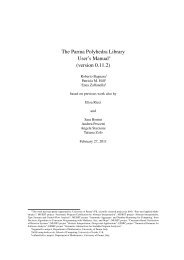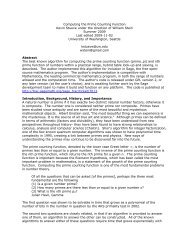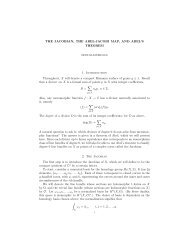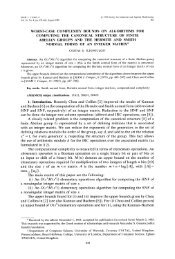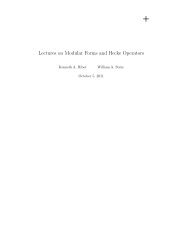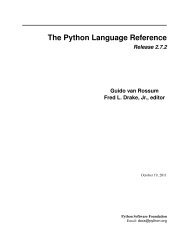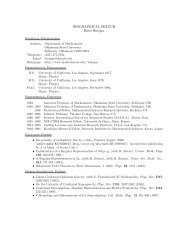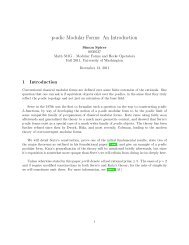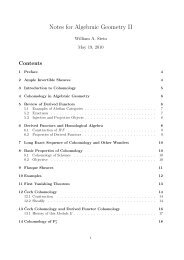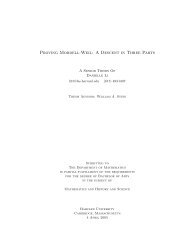Efficient implementation of the Hardy-Ramanujan ... - William Stein
Efficient implementation of the Hardy-Ramanujan ... - William Stein
Efficient implementation of the Hardy-Ramanujan ... - William Stein
You also want an ePaper? Increase the reach of your titles
YUMPU automatically turns print PDFs into web optimized ePapers that Google loves.
IMPLEMENTATION OF THE HRR FORMULA Page 15 <strong>of</strong> 19<br />
version <strong>of</strong> <strong>the</strong> FLINT partition function was tested for n up to 10 18 , giving nearly a tw<strong>of</strong>old<br />
speedup on two cores, but failed when computing 10 19 for reasons yet to be determined.)<br />
Fortunately, it is likely to be more interesting in practice to be able to evaluate p(n) for a<br />
range <strong>of</strong> large values than just for a single value, and this task naturally parallelizes well.<br />
5. Multi-evaluation and congruence generation<br />
One <strong>of</strong> <strong>the</strong> central problems concerning <strong>the</strong> partition function is <strong>the</strong> distribution <strong>of</strong> values<br />
<strong>of</strong> p(n) mod m. In 2000, Ono [On00] proved that for every prime m ≥ 5, <strong>the</strong>re exist infinitely<br />
many congruences <strong>of</strong> <strong>the</strong> type<br />
p(Ak +B) ≡ 0 mod m (5.1)<br />
where A,B are fixed and k rangesoverall nonnegativeintegers. Ono’spro<strong>of</strong>is nonconstructive,<br />
but Weaver [We01] subsequently gave an algorithm for finding congruences <strong>of</strong> this type when<br />
m ∈ {13,17,19,23,29,31}, and used <strong>the</strong> algorithm to compute 76,065 explicit congruences.<br />
Weaver’s congruences are specified by a tuple (m,l,ε) where l is a prime and ε ∈ {−1,0,1},<br />
where we unify <strong>the</strong> notation by writing (m,l,0) in place <strong>of</strong> Weaver’s (m,l). Such a tuple<br />
corresponds to a family <strong>of</strong> congruences <strong>of</strong> <strong>the</strong> form (5.1) with coefficients<br />
A = ml 4−|ε| (5.2)<br />
B = ml3−|ε| α+1<br />
24<br />
+ml 3−|ε| δ, (5.3)<br />
where α is <strong>the</strong> unique solution <strong>of</strong> ml 3−|ε| α ≡ −1 mod 24 with 1 ≤ α < 24, and where 0 ≤ δ < l<br />
is any solution <strong>of</strong><br />
{<br />
24δ ≢ −α mod l if ε = 0<br />
(5.4)<br />
(24δ +α | l) = ε if ε = ±1.<br />
The free choice <strong>of</strong> δ gives l−1 distinct congruences for a given tuple (m,l,ε) if ε = 0, and<br />
(l−1)/2 congruences if ε = ±1.<br />
Weaver’s test for congruence essentially amounts to a single evaluation <strong>of</strong> p(n) at a special<br />
point n. We give a compact statement <strong>of</strong> this procedure as Algorithm 5. To find new<br />
congruences, we simply perform a brute force search over a set <strong>of</strong> candidate primes l, calling<br />
Algorithm 5 repeatedly.<br />
n Decimal expansion Number <strong>of</strong> digits Terms Error<br />
10 12 6129000962...6867626906 1,113,996 264,526 2×10 −7<br />
10 13 5714414687...4630811575 3,522,791 787,010 3×10 −8<br />
10 14 2750960597...5564896497 11,140,072 2,350,465 −1×10 −8<br />
10 15 1365537729...3764670692 35,228,031 7,043,140 −3×10 −9<br />
10 16 9129131390...3100706231 111,400,846 21,166,305 −9×10 −10<br />
10 17 8291300791...3197824756 352,280,442 63,775,038 5×10 −10<br />
10 18 1478700310...1701612189 1,114,008,610 192,605,341 4×10 −10<br />
10 19 5646928403...3674631046 3,522,804,578 582,909,398 4×10 −11<br />
Table 2. Large values <strong>of</strong> p(n). The table also lists <strong>the</strong> number <strong>of</strong> terms N in <strong>the</strong><br />
<strong>Hardy</strong>-<strong>Ramanujan</strong>-Rademacher formula used by FLINT (<strong>the</strong>oretically bounding <strong>the</strong> error by<br />
0.25) and <strong>the</strong> difference between <strong>the</strong> floating-point sum and <strong>the</strong> rounded integer.



